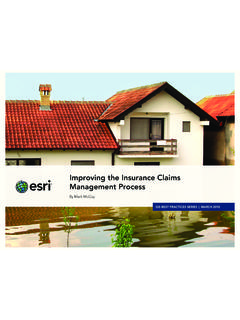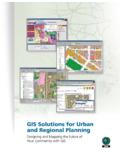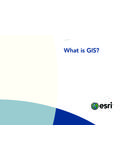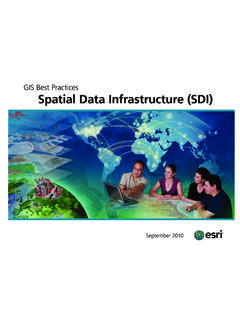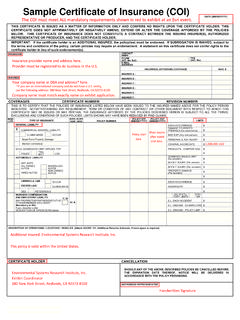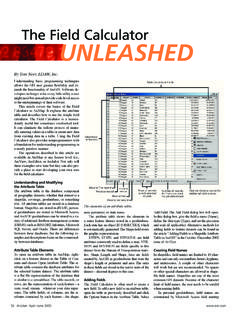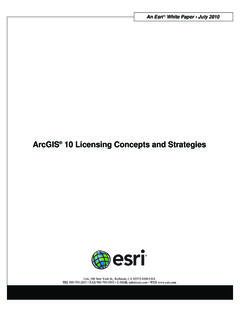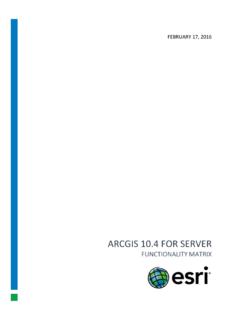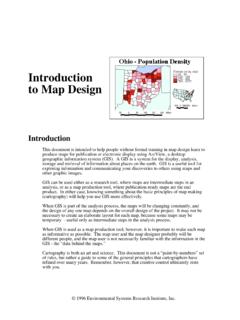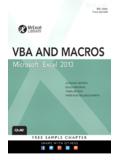Transcription of An ESRI White Paper—July 1998
1 esri shapefile Technical Description An ESRI White Paper July 1998. Copyright 1997, 1998 Environmental Systems Research Institute, Inc. All rights reserved. Printed in the United States of America. The information contained in this document is the exclusive property of Environmental Systems Research Institute, Inc. This work is protected under United States copyright law and other international copyright treaties and conventions. No part of this work may be reproduced or transmitted in any form or by any means, electronic or mechanical, including photocopying and recording, or by any information storage or retrieval system, except as expressly permitted in writing by Environmental Systems Research Institute, Inc. All requests should be sent to Attention: Contracts Manager, Environmental Systems Research Institute, Inc.
2 , 380 New York Street, Redlands, CA 92373-8100 USA. The information contained in this document is subject to change without notice. GOVERNMENT RESTRICTED/LIMITED RIGHTS. Any software, documentation, and/or data delivered hereunder is subject to the terms of the License Agreement. In no event shall the Government acquire greater than RESTRICTED/LIMITED RIGHTS. At a minimum, use, duplication, or disclosure by the Government is subject to restrictions as set forth in FAR Alternates I, II, and III (JUN. 1987); FAR (JUN 1987) and/or FAR (Commercial Technical Data/Computer Software); and DFARS (NOV 1995) (Technical Data) and/or DFARS (Computer Software), as applicable. Contractor/Manufacturer is Environmental Systems Research Institute, Inc., 380 New York Street, Redlands, CA 92373- 8100 USA.
3 In the United States and in some countries, ARC/INFO, ArcCAD, ArcView, ESRI, and PC ARC/INFO are registered trademarks; 3D Analyst, ADF, AML, ARC COGO, ARC GRID, ARC NETWORK, ARC News, ARC TIN, ARC/INFO, ARC/INFO LIBRARIAN, ARC/INFO Professional GIS, ARC/INFO The World's GIS, ArcAtlas, ArcBrowser, ArcCAD, ArcCensus, ArcCity, ArcDoc, ARCEDIT, ArcExplorer, ArcExpress, ARCPLOT, ArcPress, ArcScan, ArcScene, ArcSchool, ArcSdl, ARCSHELL, ArcStorm, ArcTools, ArcUSA, ArcUser, ArcView, ArcWorld, Atlas GIS, AtlasWare, Avenue, BusinessMAP, DAK, DATABASE INTEGRATOR, DBI Kit, ESRI, ESRI Team GIS, ESRI The GIS People, FormEdit, Geographic Design System, GIS by ESRI, GIS for Everyone, GISData Server, IMAGE. INTEGRATOR, InsiteMAP, MapCaf , MapObjects, NetEngine, PC ARC/INFO, PC ARCEDIT, PC ARCPLOT, PC ARCSHELL, PC DATA CONVERSION, PC NETWORK, PC OVERLAY, PC STARTER KIT, PC TABLES, SDE, SML, Spatial Database Engine, StreetMap, TABLES, the ARC COGO logo, the ARC GRID logo, the ARC NETWORK.
4 Logo, the ARC TIN logo, the ARC/INFO logo, the ArcCAD logo, the ArcCAD WorkBench logo, the ArcData emblem, the ArcData logo, the ArcData Online logo, the ARCEDIT logo, the ArcExplorer logo, the ArcExpress logo, the ARCPLOT logo, the ArcPress logo, the ArcPress for ArcView logo, the ArcScan logo, the ArcStorm logo, the ArcTools logo, the ArcView 3D Analyst logo, the ArcView Data Publisher logo, the ArcView GIS logo, the ArcView Internet Map Server logo, the ArcView Network Analyst logo, the ArcView Spatial Analyst logo, the ArcView StreetMap logo, the Atlas GIS logo, the Avenue logo, the BusinessMAP logo, the BusinessMAP PRO logo, the Common Design Mark, the DAK logo, the ESRI corporate logo, the ESRI globe logo, the MapCaf logo, the MapObjects logo, the MapObjects Internet Map Server logo, the NetEngine logo, the PC ARC/INFO logo, the SDE logo, the SDE CAD Client logo, The World's Leading Desktop GIS, ViewMaker, Water Writes, and Your Personal Geographic Information System are trademarks; and ArcData, ARCMAIL, ArcOpen, ArcQuest, ArcWatch, ArcWeb, Rent-a-Tech, , and are service marks of Environmental Systems Research Institute, Inc.
5 The names of other companies and products herein are trademarks or registered trademarks of their respective trademark owners. J-7855. esri shapefile Technical Description An ESRI White Paper Contents Page Why Shapefiles? 1. shapefile Technical Description 2. Organization of the Main File 2. Main File Record Contents 5. Organization of the Index File 23. Organization of the dBASE File 25. Glossary 26. ESRI White Paper i J-7855. esri shapefile Technical Description This document defines the shapefile (.shp) spatial data format and describes why shapefiles are important. It lists the tools available in Environmental Systems Research Institute, Inc. (ESRI), software for creating shapefiles directly or converting data into shapefiles from other formats. This document also provides all the technical information necessary for writing a computer program to create shapefiles without the use of ESRI software for organizations that want to write their own data translators.
6 Why Shapefiles? A shapefile stores nontopological geometry and attribute information for the spatial features in a data set. The geometry for a feature is stored as a shape comprising a set of vector coordinates. Because shapefiles do not have the processing overhead of a topological data structure, they have advantages over other data sources such as faster drawing speed and edit ability. Shapefiles handle single features that overlap or that are noncontiguous. They also typically require less disk space and are easier to read and write. Shapefiles can support point, line, and area features. Area features are represented as closed loop, double-digitized polygons. Attributes are held in a dBASE format file. Each attribute record has a one-to-one relationship with the associated shape record.
7 How Shapefiles Shapefiles can be created with the following four general methods: Can Be Created Export Shapefiles can be created by exporting any data source to a shapefile using ARC/INFO , PC ARC/INFO , Spatial Database Engine (SDE ), ArcView GIS, or BusinessMAP software. Digitize Shapefiles can be created directly by digitizing shapes using ArcView GIS. feature creation tools. Programming Using Avenue (ArcView GIS), MapObjects , ARC Macro Language (AML ) (ARC/INFO), or Simple Macro Language (SML ). (PC ARC/INFO) software, you can create shapefiles within your programs. Write directly to the shapefile specifications by creating a program. ESRI White Paper esri shapefile Technical Description J-7855. SDE, ARC/INFO, PC ARC/INFO, Data Automation Kit (DAK ), and ArcCAD . software provide shape-to-coverage data translators, and ARC/INFO also provides a coverage-to-shape translator.
8 For exchange with other data formats, the shapefile specifications are published in this paper. Other data streams, such as those from global positioning system (GPS) receivers, can also be stored as shapefiles or X,Y event tables. shapefile Technical Computer programs can be created to read or write shapefiles using the technical Description specification in this section. An esri shapefile consists of a main file, an index file, and a dBASE table. The main file is a direct access, variable-record-length file in which each record describes a shape with a list of its vertices. In the index file, each record contains the offset of the corresponding main file record from the beginning of the main file. The dBASE table contains feature attributes with one record per feature. The one-to-one relationship between geometry and attributes is based on record number.
9 Attribute records in the dBASE file must be in the same order as records in the main file. Naming Conventions All file names adhere to the naming convention. The main file, the index file, and the dBASE file have the same prefix. The prefix must start with an alphanumeric character (a Z, 0 9), followed by zero or up to seven characters (a Z, 0 9, _, -). The suffix for the main file is .shp. The suffix for the index file is .shx. The suffix for the dBASE table is .dbf. All letters in a file name are in lower case on operating systems with case sensitive file names. Examples Main file: Index file: dBASE table: Numeric Types A shapefile stores integer and double-precision numbers. The remainder of this document will refer to the following types: Integer: Signed 32-bit integer (4 bytes).
10 Double: Signed 64-bit IEEE double-precision floating point number (8 bytes). Floating point numbers must be numeric values. Positive infinity, negative infinity, and Not-a-Number (NaN) values are not allowed in shapefiles. Nevertheless, shapefiles support the concept of "no data" values, but they are currently used only for measures. 38. Any floating point number smaller than 10 is considered by a shapefile reader to represent a "no data" value. The first section below describes the general structure and organization of the shapefile . The second section describes the record contents for each type of shape supported in the shapefile . Organization of the The main file (.shp) contains a fixed-length file header followed by variable-length Main File records. Each variable-length record is made up of a fixed-length record header followed by variable-length record contents.
